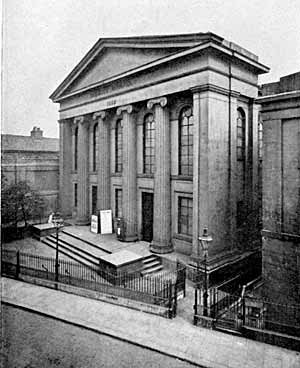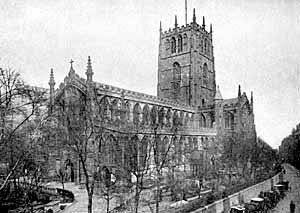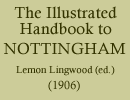< Previous | Contents | Next >
Chapter IV.
Nottingham churches past and present. Part I.
PERHAPS it would have been better to head this Chapter "Mainly About Churches," for, while we intend them to be our principal subject, we shall take the opportunity of mentioning any secular objects of interest that may be met with in the course of a religious pilgrimage.
The route we recommend is to leave the Market Place by King Street, and, at the top, turn to the right and keep straight on, over the Bridge crossing the Great Central Railway until George Street is reached. In this street are a Baptist Church (erected 1815, for the original Baptist Church in Friar Lane), and St. Paul's Anglican Church (erected 1839), a stone building with classic portico, supporting a small tower, ornamented with a circle of columns, on which rests a dome. The Roman Catholic Church in George Street, since used as a school and now vacated, was built in 1827. It superseded a smaller building in King's Place, Stoney Street. Further along Lower Parliament Street we come to Broad Street, running parallel with George Street, after passing the Methodist New Connexion Church. This denomination separated from "Wesleyan" Methodism in 1797, and obtained possession of the Chapel in Hockley, whence they migrated in 1817 to their present position. Looking down King Edward Street, the belfry of St. Catharine's can just be seen. This Church will be found open, and is worth a visit as a good example of plain English Gothic taken from the best early examples (opened 1896).
Monasteries;—
Knights Hospitallers, Order of St. John of Jerusalem.
We now stand at the top of St. John Street. The name is taken from the Hospital of St. John, which was in the hands of a community of soldier-monks, and occupied a site in this neighbourhood, just outside the old town wall. The well-known "St. John Ambulance Association" gets its name from the same source.
The Grey Friars, or Franciscans, have left their trace on the town by giving a name to Greyfriar Gate (which we shall see in a future excursion). This Order was introduced by Henrv III., and the Community occupied a house in Broad Marsh, near the street to which it has given a name. At the present day religion is represented in this district by Our Lady and St. Patrick's (Roman Catholic), Canaan Church, Broad Marsh (Primitive Methodist), and St. John the Baptist's, Leen Side (1844).
The White Friars, or Carmelites, settled in Nottingham somewhat later than the last-mentioned. They give the name to the still-existing Friar Lane (near South Parade, which we have seen, p. 58). The Carmelite Friars also give the name indirectly to the Friary Congregational Church, West Bridgford. This congregation formerly met at Friar Lane Congregational Chapel (said to have been the first Gothic Chapel in Nottingham, 1828), now secularised. The Society of Friends also occupy a site within the old Friars' precincts, having an excellent Meeting House on the right hand side of Friar Lane. They formerly had a place in the adjoining Spaniel Row, founded 1689.
Lenton Priory of Cluniac Monks.
The oldest and most powerful monastery in this neighbourhood, was that founded by William Peverel, temp. Henry I., at Lenton, then a village 11/2 miles from Nottingham, now a thriving suburb, to which the car will take us in about ten minutes. The Priory of Lenton obtained the patronage of St. Mary's, the principal Nottingham Church, and very jealously guarded its privileges from encroachments by the neighbouring monks of St. John. The remains of Lenton Priory may be seen at Old Lenton, half a mile's walk from where the tram sets us down at New Lenton. The restored portion of the Priory is used as a Mission Chapel to Lenton Parish Church (built 1842, Rev. Alan Watts, M.A.).
Wesleyan Methodism.

Wesleyan Chapel, Broad Street.
Turning along Broad Street we come to a large building with wide front, ornamented with massive Corinthian columns. This is Wesley Chapel, erected 1837, and belonging to the original Connexion founded by John Wesley, sometimes called the "Old Body" to distinguish it from its numerous offshoots. This roomy galleried building will probably hold nearly two thousand people, andmusters a very good congregation on Sunday evenings. The Founder of Methodism first visited Nottingham in 1741, and again in 1743, accompanied by his brother Charles (the Keble of the movement). The Malt Cross was a common seat of their ministrations. The first Methodist place of worship, the Octagon, situated behind Milton Street, near the present site of the Great Central Railway, was erected in 1767, and replaced by Hockley Chapel, 1782. At the opening of the last-named in the morning, the Rev. Dr. Coke read the Prayer Book Service and Wesley preached from the Epistle for the day (Heb. ix. 11, 12). Both wore the usual vestments, the service concluding with Holy Communion. The Great Chapel in Halifax Place (still in use) was erected in 1799, rebuilt 1847. Chapels in Mansfield Road, Tennyson Street and Arkwright Street, date from the Seventies. The Wesleyan Methodist Church continues to make new ventures, one of its latest being the acquisition in 1901 of the Albert Hall, Derby Road. This was used as a Mission Hall until it was unfortunately burnt down, April 22nd, 1906.
The Lace Market.
Adjoining Wesley Chapel is a white-painted building of Corinthian design, the Public Dispensary. This most valuable Charity employs three resident doctors. Its Board Room accommodates the Library of the Nottingham Medico-Chirurgical Society, consisting of more than one hundred members. Here also the Society holds fortnightly meetings during the winter. Crossing the top of Goose Gate we find ourselves in Stoney Street, the centre of the Lace Market. This narrow street, as well as St. Mary's Gate, which runs parallel with it, is composed of warehouses from end to end, many being handsome buildings, notably that occupied by Messrs. Thomas Adams & Co., one of the largest in the town. In Stoney Street we pass a small gabled building with a coat of arms bearing three ravens. This was formerly the High School, which was held on the same site for three hundred years. Further on a signboard shows us the way to St. Mary's Hall. This is an erstwhile Baptist Chapel, now accommodating St. Mary's Week-day and Sunday Schools.
Parish Church of St. Mary the Virgin.

St Marys Church.
We are now in sight of St. Mary's Church, situated in an extensive graveyard. We are at once struck by its noble proportions and massive central tower, which can be seen from most parts of the city. St. Mary's is the mother church from which all the rest, of whatever denomination, have sprung, and for this reason among others deserves our careful attention. The present structure dates from about the year 1400, the Early Perpendicular Period—that is, when the flowing tracery of the windows became replaced by vertical lines. The tower is finished by a battlemented parapet, and a similar device, artistically panelled, surrounds the nave, aisles, and transepts. The chancel is of altogether poorer design, and is without aisles. The three great windows, occupying the transepts and west end, are uniform in size and design, and are of magnificent proportions. The west end is not original work, but dates from 1848, being a very good copy, taken from early prints, of the old front. Previous to this there existed a classic composition made up ot Doric pillars, round arches, and pediments.
There was at least one earlier church, and probably more, on the site. It is known that some of the present columns rest on sculptured capitals and other Norman and Early English remains. Inside the church, under the floor, can be seen the base of an Early English clustered column.
Interior. We enter by the south porch, which though somewhat decayed, nevertheless, still shows great richness of design. The bronze folding doors to the church are the gift of Rev. Stephen Morse, in memory of his father, in 1905. The figures in relief on the panels represent scenes from the life of the Virgin.
On entering we are struck by the noble spaciousness of the edifice, by the lightness and grace of the columns supporting the lofty roof of the nave, and by the remarkable size and beauty of the transepts forming the arms of the cross. The beautiful groined ceiling under the tower is of oak, but unless you were told, you would believe, as you are intended to do, that it is stone vaulting.
One of the most treasured ornaments of the church is the picture, "Madonna and Child," by Fra Bartolomeo. It was presented in 1839 by Mr. Thomas Wright, of Upton Hall. We next notice the oaken rood-screen, presented in 1885 by Mr. T. Hill, who also gave the Altar Piece, composed of a series of scriptural subjects painted on panels, e.g. "Christ the Good Shepherd," "The Crucifixion," etc. The stained window on the north of the sanctuary was given to commemorate Mr. and Mrs. Hebden, while that on the south is in memory of Canon Morse, Vicar of this church, 1864-84. If you seek a monument to his successor, the Ven. Archdeacon Richardson, now Rector of Southwell Cathedral, the answer is the same as that given on the tomb of Sir Christopher Wren:—Circumspice. (The fine vestry adjoining, designed by Bodley; St. Mary's Hall; the Plumptre Street Clergy House, now exchanged for one on Kaye's Walk, and other improvements in the fabric of St. Mary's, are largely due to his generosity and enterprise.)
In the chancel wall, preserved under glass, is a sculptured group, discovered during repairs to the fabric, representing a Pope attended by Cardinals blessing a Bishop. The figures have been thought to be intended for Gregory the Great, sending St. Augustine on his mission to England. Notice the carved oak choir stalls and Bishop's throne. The oldest glass in the church is in the east window of the chancel, erected about forty years ago to the memory of H.R.H. Prince Albert (Consort of Queen Victoria), not a very good example of the art. Several of the long windows in the north and south walls have a very pleasing effect; among them are the memorials to Lord Belper, Mr. R. Paterson, Sir Charles Fellows, Mr. William Wright.
North Transept. The glass, representing the Parables of our Lord, partly filling the large window is in memory of a former Vicar, Canon Brooks. There are two monumental slabs, early eighteenth century, to members of the Plumtre family, and the large tomb with richly carved canopy commemorates Thomas Thurland. In pre-reformation times there were chantry chapels in both transepts. Several large Guilds also met in the church.
South Transept. Here is another large canopied tomb, with recumbent effigy, the burial-place of the Salmon family. Here also the Earls of Clare had their chapel; one of their monuments still remains, while another, no ornament to the church, has been removed. The great south window depicts the Parables, and the lower tier of windows at the sides of the transept also contain stained glass. Some memorials also, of our recent losses, must be mentioned, namely two Brasses, erected respectively to the members of the Robin Hood Rifles and of the Sherwood Foresters who fell during the war 1899-1902.
In the South Aisle of the Nave is a sumptuous Brass, three stained windows, and a tablet containing a list of names, in commemoration of all local men who fell in the war. The inscription on the tablet runs:—
Following the south aisle we come to several other beautiful windows by Kemp. The Baptismal Font is near the south-west angle. The great west window is in memory of Mr. Thomas Adams, a leading merchant of the City. Along the North Aisle we notice various monuments, somewhat commonplace, and a mutilated figure from a tomb, no longer existing. There are two sets of Colours, belonging to the old Notts Regiment. There is an interesting old doorway on this side, with arched moulding resting on corbels, carved to represent a King and Queen. The Original Door is there too! Notice its thick ribs of native oak and heavy old lock.
St. Mary's is always open to visitors, who will receive every attention from the obliging Sacristan, Mr. George Hudson.
The present Vicar is the Right Rev. A. Hamilton Baynes, late Bishop of Natal*.
< Previous | Contents | Next >
* Author of My Diocese during the War, 1900.
